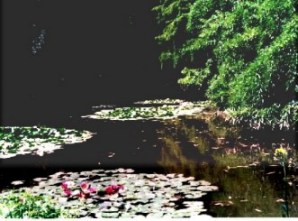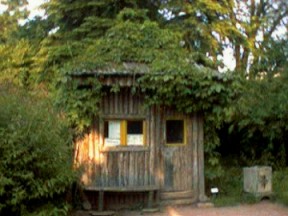ARBORETUMUL SIMERIA
MONUMENT OF LANDSCAPE ARCHITECTURE
ing. Flaviu POPESCU; dr.ing.Stelian RADU; ing. Corina COANDA
Forest Research and Management Institute - Station Simeria

 The originality and lay-out value of landscapes from the 50 parcels of the park (70 ha) is put on a
different relief, having lakes and sources, with groves and winding alleys, all combined in a natural
dynamic and almost new assembly.
The originality and lay-out value of landscapes from the 50 parcels of the park (70 ha) is put on a
different relief, having lakes and sources, with groves and winding alleys, all combined in a natural
dynamic and almost new assembly.
The entrance in Arboretum is marked by the solemnity of pyramidal oaks, having vegetation from with
symmetrical outline combined with the white architectural background of the building and with its pillars.
The 2 access point symmetrical disposed specific to nobility buildings, a lunge carpet of juniper-tree
(Juniperus sabina L.) from rich are rising 2 brush samples that have umbrella corona (Sophora japonica L.
var. pendula Zbl. And Morus alba L. var. pendula Dipp.) outlined at the external parts with a border of roses.
Standing on the northern terrace of the building opposite the entrance, it can be seen an amazing landscape. The layout
structure is realized through the forms combination, the greatness characteristic for the monumental trees that have tabular
coronas at maturity age (Pinus strobus L.), 
 fastigiate (Thuja plicata Mast.) or pendent (Metasequoia glyptostroboides,
Chamaecyparis
nootkatensis
(D.Don.) Spach.),
with regularity of
globular coronas
(Prunus serulata
Lindl., Buxus
sempervirens L. var.
arborescens L.,
Buxus sempervirens
L. var. suffruticosa) and the bamboo curtain (Phyllostachys viridi
- glaucescens A.&C. Riviere). The rate between volumes and
spaces, between grandeur and delicacy, the contrast between lights and shadows, the nice color combination envelop the
whole terrace in glamour and harmony.
fastigiate (Thuja plicata Mast.) or pendent (Metasequoia glyptostroboides,
Chamaecyparis
nootkatensis
(D.Don.) Spach.),
with regularity of
globular coronas
(Prunus serulata
Lindl., Buxus
sempervirens L. var.
arborescens L.,
Buxus sempervirens
L. var. suffruticosa) and the bamboo curtain (Phyllostachys viridi
- glaucescens A.&C. Riviere). The rate between volumes and
spaces, between grandeur and delicacy, the contrast between lights and shadows, the nice color combination envelop the
whole terrace in glamour and harmony.
Coming down from the upper terrace to the center of the park, on the winding alleys, having abrupt or soft slopes under the
vault of Buxus you can get into the vegetal paradise of park.

We get at the lake area, shining mirrors, which reflect monumental samples of pyramidal oaks (Quercus robur var. fastigiata
(Lam.) Schw., Taxodium distichum L. and Metasequoia glyptostroboides). On the 
 quiet surface of the lakes there are
resting red and white water
lilies, and this pictures offers the
possibility of landscape layout
contemplation. Trees and exotic
or native brushes, leafy and
resinous trees having coronas
with different forms and highs,
are aligned into a harmony of
colors and nuances, and lights
and shadows masking one of the most wanted and nicest place in the
park. The main alleys are large and sinusoidal show the landscape and
tree riches using the alternation and the contrast between colors, nuances
and forms given by vegetation disposing in many plans, and groves with brushes and perennial plants. The soft or sharp
passing from sunny areas to shadow corners urges visitor's interest and attention.
quiet surface of the lakes there are
resting red and white water
lilies, and this pictures offers the
possibility of landscape layout
contemplation. Trees and exotic
or native brushes, leafy and
resinous trees having coronas
with different forms and highs,
are aligned into a harmony of
colors and nuances, and lights
and shadows masking one of the most wanted and nicest place in the
park. The main alleys are large and sinusoidal show the landscape and
tree riches using the alternation and the contrast between colors, nuances
and forms given by vegetation disposing in many plans, and groves with brushes and perennial plants. The soft or sharp
passing from sunny areas to shadow corners urges visitor's interest and attention.
 The secondary alleys, narrow, have a winding aspect being curved,
developing pictures and perspectives or changes of spectacular structures,
just by doing a few steps.
The secondary alleys, narrow, have a winding aspect being curved,
developing pictures and perspectives or changes of spectacular structures,
just by doing a few steps.
Trees and decorative bushes, having abundant flowering, are lacing the
alleys and the limits of massive, remembering grace and elegance of Asian
gardens (Japanese and Chinese).
The Strei - river - crosses the park trough an artificial channel and goes
softly to the Mures River.
The first areas, described above, lies on the upper terrace till to Strei
channel. The layout picture has a restricted area (5.4 ha), a great variety of
landscapes made by various species of bushes and trees, lakes sources all
of then being put on a various relief, without giving an artificial impress.
In the second area, situated between Strei - channel and Mures River, the relief is almost flat, and the architecture and
landscape effect combine the exotic elements with the natural vegetation existing on the river meadow. The natural vegetation
powerful developed, disposed mainly into stairs, having numerous impenetrable tickets, offer a various scale of associations
and aspects: riverside locust - trees, riverside coppice with white and black poplars, with bodies covered by ivy (Hedera helix
D.C.) or Parthenocissus quinquefolia (L.) Planch., representing fragments from ex-bushes that lived on the riverside meadows,
having a wild forest (virgin) aspect.  They intersect with bunches of exotic resinous (Juniperus virginiana L. and pine
collections) and exotic leafy (Juglans sp., Carya sp., etc) rarely groves,
glades with lonely gigantic trees, that have grandiose forms (oaks,
poplars, plane - tree, magnolia) all being grafted on the natural
vegetation structure of river meadow. In this way it is released a great
layout diversity (mixes of native and exotic species) and a rare
landscape diversity. At these are addes the delicate passing to small
pure groups of resinous having structured and chromatic combination
that contrast with the leafy, although they are integrated harmoniously
into the assembly unity of landscape.
They intersect with bunches of exotic resinous (Juniperus virginiana L. and pine
collections) and exotic leafy (Juglans sp., Carya sp., etc) rarely groves,
glades with lonely gigantic trees, that have grandiose forms (oaks,
poplars, plane - tree, magnolia) all being grafted on the natural
vegetation structure of river meadow. In this way it is released a great
layout diversity (mixes of native and exotic species) and a rare
landscape diversity. At these are addes the delicate passing to small
pure groups of resinous having structured and chromatic combination
that contrast with the leafy, although they are integrated harmoniously
into the assembly unity of landscape.
The chromatic change series due to succession of seasons in spectacular
and only a good understanding of landscape architecture may lead to a
better knowledge and labor appreciation during the centuries in the
planning and harmony creation of landscapes and beauties of Arboretum Simeria.
 From the multitude of landscapes that develop all over the year, we have to
remember the "magnolia symphony" a real overflow of purity and delicateness.
The great number of species (10) but also the magnolia samples, with an
abundant flowering and having a chromatic rarely found trough the country,
increases considerable the beauty and elegance of Arboretum, leaving
unforgettable impression on visitor's missed.
From the multitude of landscapes that develop all over the year, we have to
remember the "magnolia symphony" a real overflow of purity and delicateness.
The great number of species (10) but also the magnolia samples, with an
abundant flowering and having a chromatic rarely found trough the country,
increases considerable the beauty and elegance of Arboretum, leaving
unforgettable impression on visitor's missed.
The "magnolia symphony" starts in the second half of the March (Magnolia
kobus D.C., Magnolia denudata Desr., Magnolia stellata (S&Z) Maxim.), in
April are Magnolia x soulangiana Soulange-Bodin, Magnolia liliflora Desr.,
Magnolia tripetala L., Magnolia obovata Thunb., and the end it is marked in July
by Magnolia macrophylla Michns. and Magnolia virginiana L.
It's a real and wise collaboration between man and nature. The luxurious
increases the quality of landscapes and the high level of maintenance, can be
noticed even by an unauthorized a visitor, who hardly imagine the great number and the intensity of attempt that led to this
oases of beauty and purity. This attempts were many and various catastrophic overflows (in 1970, 1974 and 1975); the soft
snows (1958); the storms (1960, 1962, 1969, 1992); prolonged droughts (1946 - 1947, 1950, 1984, 1996); severe colds
(1963, 1985); elms drying (after 1959) the descending of subsoil water and not the last industrial pollution.
The efforts and the special passion, constantly showed trough the years by a registered collective of ICAS Station Simeria
made healthy again the wonderful park.
Photo: Radu Stelian, Corina Coanda, Jan Dobbelmann
For further questions or comments about this web site send a message to icashd@rdslink.ro
Copyright © 2001 ICAS Research Station Simeria - Ovidiu Iordan